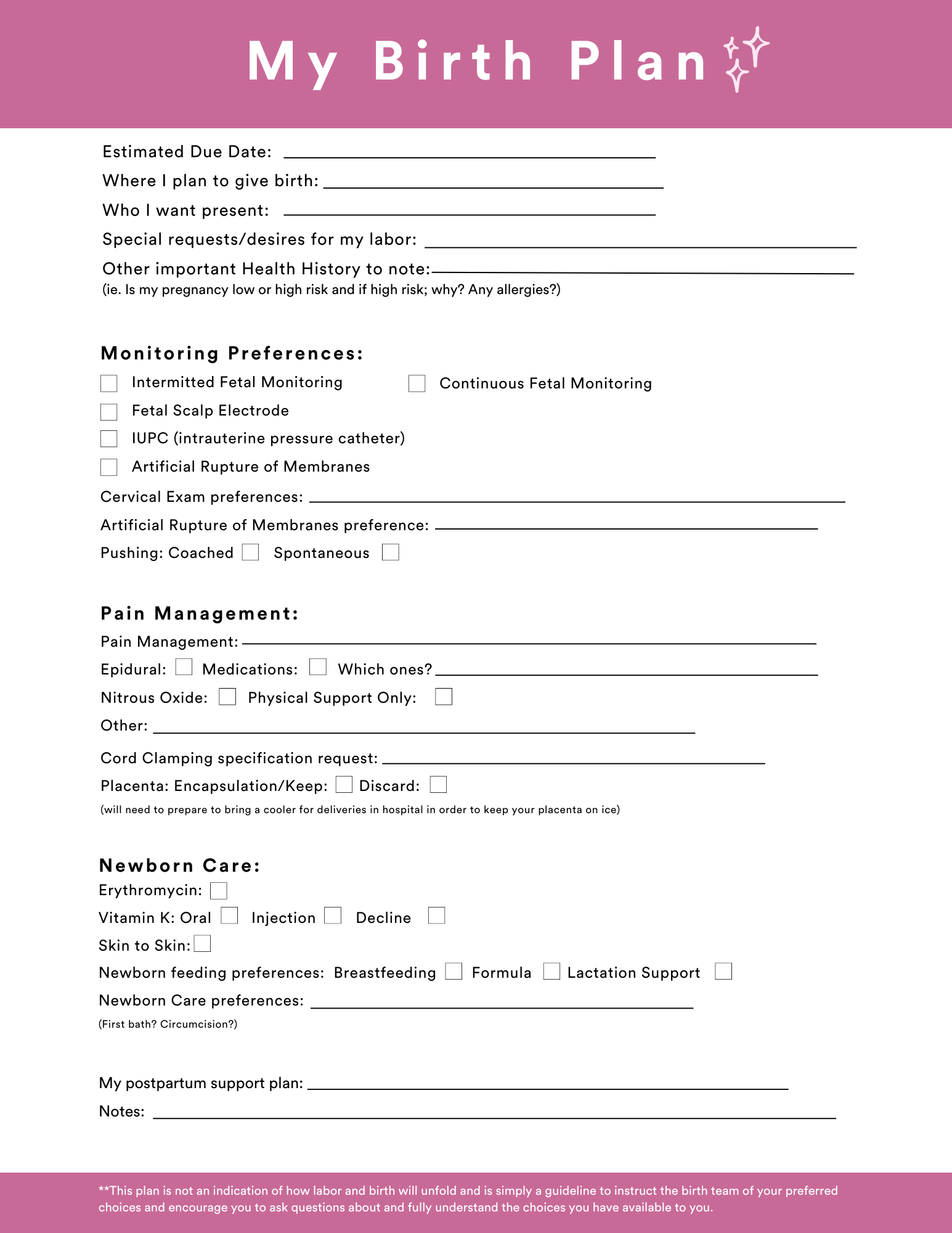Birth Plans: What should you really focus on?
Author: Alison Stoffel, Certified Birth Doula
For most women in our society, the norm has been to head into the hospital, get checked, maybe get an epidural, have a baby, and overall leave their birth in the hands of the OB. Sometimes, the birth experience can come as a surprise when you don’t know what to expect. As our medical system changes over time, women are choosing to wield a bit more autonomy in their prenatal care, births, and postpartum experience. The first and simplest step is forming a concise birth plan.
Traditionally, women birthed at home with a midwife! It wasn’t until the 1930’s that women began birthing with a male doctor or in a hospital. The shift we are seeing today is the transition to women taking charge of their births, whether that means planning a homebirth or birth center birth with a midwife, birthing in the hospital with a detailed birth plan, or even birthing unassisted. A birth plan is just the beginning of a very important step to re-empowering women in their innate physiological expertise in birth. A birth plan is a simple and yet powerful way to begin re-educating our zealous generation on labor, birth, and postpartum care.
In order to create a birth plan that makes sense for you, you will need to invest your time and effort in choosing the type of care you wish to receive, and gain a thorough understanding of the traditional options and procedures available to you. Cervical exams, continuous fetal monitoring, Vitamin K, and erythromycin are some of these standard procedures done during labor and immediate postpartum. Stating your desires and expectations of the care you wish to receive from your provider ahead of time is essential! Arriving in the thick of labor is undoubtedly the worst time to come up with a birth plan, or have your provider asking questions you haven’t yet considered.
What is a Birth Plan?
A collaborative birth plan is just the stepping stone to encouraging parents to choose their preferences, why they want or don’t want what is available to them, and ultimately creating an opportunity for education regarding one of the most vulnerable and important days in their life.
Let’s consider what your birth plan should include! Ask yourself these questions first.
Your Birthing Space:
Where do I feel safe to give birth? If your answer is the hospital, confirm that the provider you’ve chosen delivers at this hospital. If your answer is at home or in a birth center, then consider what options are available to you in your area to plan a safe home birth, which midwife you may want to work with, etc.
People in the Room:
Who do I want in my birth space? A doula? My partner? My children? My mother or mother in law? Who do I not want in my birth space? All of these require careful consideration, and depending on who you want present at your birth may impact the location in which you plan to deliver. Most hospitals have strict policies on the number of persons allowed in the delivery room. Additionally, alerting your family of who you plan to have (or not have) in attendance before labor begins can prevent the degree of disappointment in your excited loved ones.
Environment:
What is important to me to have access to during labor? Do you enjoy certain music, specific aromas, low lighting, hushed voices, freedom to move around, special foods? Writing down your wishes can inform your nurses or birth team what will make your individual experience just that little bit better.
Atmosphere:
What kind of postpartum atmosphere do I desire? Is it a room filled with family and friends? Is it just your partner and your new little one for the first day or so? What plan do I have for support in those first two weeks? Can my well-meaning, excited family bring meals over and fold laundry? The postpartum time is just as much a part of birth as the birth itself, and should not go unaddressed in a birth plan.
Feeding:
Are you planning to breastfeed or formula feed, and do you have sufficient support? Having a lactation consultant on your resources list can help alleviate stress and troubleshoot some things that can come up in the journey of breastfeeding and even formula feeding!
Individually Tailored Birth Plan Aspects:
Some key details to research and consider for your individually tailored birth plan:
Cervical Exams:
Cervical exams are a way your healthcare provider can assess your cervix's dilation, effacement, station, position, and consistency during labor. How often, if at all are you comfortable with? What do they mean, and by whom will it be performed?
Induction:
To plan to induce is a big decision and should not be taken lightly as it can drastically impact your labor and birth. Discuss possible reasons for a medically recommended induction with your provider.
Monitoring:
Intermittent: Keeping tabs on your baby’s well-being by heartbeat can be done intermittently for low risk laboring mothers, and can often allow for a much more enjoyable active labor.
Continuous: The well-known straps around the belly to measure heartbeat and contraction strength for the duration of your labor.
FSE (fetal scalp electrode): an electrode attached to your baby’s scalp to allow for monitoring of the babies heartbeat. This is not commonly done as a way of monitoring low risk babies, but could arise as an option presented during an intense labor. Therefore, it should be something you know beforehand whether you wish to utilize this tool, as it is your choice.
Position Changes
In labor or water birth, changing positions to push, laboring in the tub, and choosing the position you wish to be in is your right.
Pain Management
Do you plan to take advantage of the medications available to you, like an Epidural or Nitrous Oxide, during labor? If so, research what you may or may not be interested in and include this in your birth plan!
Pushing
Do you wish to have guidance when it comes to pushing (coached pushing) your baby out or would you prefer to let your body do the pushing (spontaneous pushing)? Learn the effects different types of pushing can have on perineal tearing, determine which is right for you, and understand it may change in time of labor.
Breaking your Water
Also known as “rupture of membranes”, it is common for this to be offered to you during a long labor, and you should understand the risks and benefits of this intervention.
Cutting the Cord
Who will cut it? Are you interested in delayed clamping?
C-section
In the case of a C-section, do you want to be able to watch the delivery? Who do you want in the operating room with you? Do you want to facilitate skin-to-skin if possible?
Vitamin K
Oral or IM? Do your research on why babies are commonly given Vitamin K at birth, and determine which method of administration you would choose for your baby if they need it!
Erythromycin
Research whether your baby is a candidate for receiving this eye ointment and whether you wish to have your birth team administer it
Placenta
Do you plan to keep it? List your desire for what to do with your placenta on your birth plan!
Photography/videography
Do you wish to have visual records of your birth and does your chosen location of birth allow it?
Skin-to-skin
Do you want your baby on your chest right away? Does your partner want to engage in skin-to skin during that golden hour?
Latching to Nurse
Do you want to be guided right away? Do you want the chance to figure it out with your baby and ask for help if you need it? A simple choice when you are learning how to latch can make all the difference in how capable and confident a mother feels, as everyone has different expectations and desires and your birth team cannot read your mind!
Creating a Birth Plan
As you can see, it may seem to be a lot more than anticipated to create a birth plan. However, once you’ve asked these questions and educated yourself on what is important to you, it’s actually quite simple. Jotting down a birth plan can be the path to a truly indispensable education you have invested in to prepare you to bring your baby into this world . Highlighting the importance of what feels safe for you, listening to your intuition, and trusting your body’s ability to birth is the bottom line.
Ready to Create your own Birth Plan?
The author has created a birth plan template for you to print, fill out, and include in your hospital bag when you’re ready to give birth. Spend some time on this birth plan and even collaborate with your doctor, midwife, or doula, and your support system.
Meet the Author:
Alison is a certified birth and postpartum doula currently working in Central Virginia and is very passionate about supporting women and their families throughout this transforming time in their lives. She is also pursuing licensure as a midwife in order to support families interested in homebirth and is nearing the finish line. Processing fears and worries before birth is a high priority during prenatal discussions with clients and she deeply values closeness and friendship. She was brought to the world of pregnancy and labor support after the birth of her daughter (age 6) in which she felt truly inspired by the transformative experience. Outside of birth work, Alison enjoys time with her daughter, riding her horse, and diving into a historic novel.
Connect with Maternal by Sentido
Our team is dedicated to providing the highest quality breast pumps through insurance and getting to know you as a mom and guiding you through your maternal health journey.
Maternal by Sentido has an online community offering informative blogs, downloadable material, and social media that will carry you through your maternal health journey.



